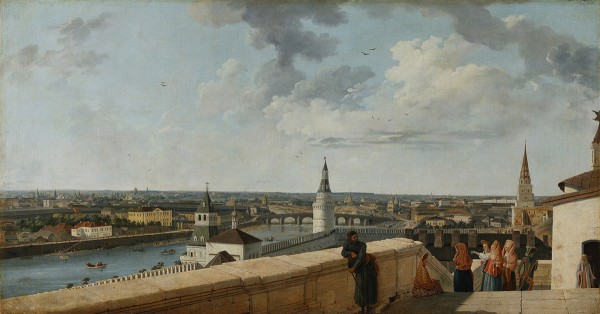The artist is Delabart

“At the end of the XVIII – mid -19th century, a distinctive outfit of women of a simple estate was covered with“ grooves ”with gold – there were such capes at a hundred rubles or more; To leave without such a cloak from the house was revered for shame … ”(Pylyaev, 2007. With. 61)
Grozato bedspreads or groove veils, according to the name of the Syrian city, where silk was produced, a large scarf rectangular shawl, which was thrown onto the headdress and shoulders. Perhaps Pylyaev “overestimated” the cost of the groove, other researchers mention prices from seven to forty -five rubles (Arsenyeva, b/g). But in the saying “Gol is rude, and the veil is a groove” is surprising that poor people could wear this expensive addition of a suit. Women’s folk costume in Russia of the XVIII – XX centuries. SPb, 2013. With.thirty.
Work is the second part of the panorama of Moscow, performed from the balcony of the Imperial Kremlin Palace. The panorama of Moscow was ordered by Delabart by Emperor Paul I in 1797; In the same year, Delabart wrote the left part of the panorama (a view of Moscow from the balcony of the Kremlin Palace towards the Moskvoretsky Bridge, the right was finished a year later. In the signature under the engraving, Delabart, already well -oriented in Moscow, considered it necessary to list the main attractions: “Here you can see: the stone bridge, part of the Kremlin insides and everything that is on this side in the city and outside the city is located. Former Vorobyevsky Palace ends the appearance of this.””
A close-up depicts part of the Kremlin wall adjacent to the Moscow River with the Sviblovaya (Vodovzavodnaya), Blagoveshchenskaya, Borovitskaya towers. Left – a stone bridge, behind the river – the buildings of Zamoskvorechye, in the distance – Vorobyovs Gory.
The picture shows many buildings that have not survived to this day: behind the stone bridge, the Church of Nicholas the Wonderworker on Bersenevka (demolished in 1854), on the opposite bank of the River of the Stone Corps of the Bolshoi Cloth Yard (1705), also demolished, already in 1937.
Leave a Reply